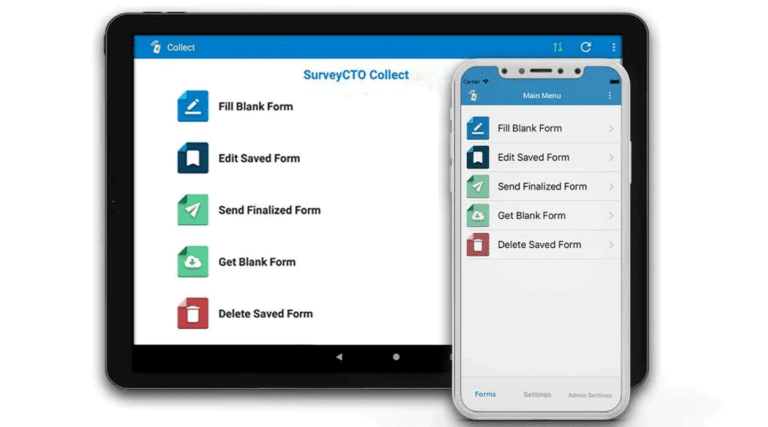
Whether your field is development economics, international development, the nonprofit sector, or myriad other industries, effective data collection is essential. It informs decision-making and increases your organization’s impact. However, the process of data collection can be complex and challenging.
If you’re in the beginning stages of creating a data collection process, this guide is for you. It outlines tested methods, efficient procedures, and effective tools to help you improve your data collection activities and outcomes.
At SurveyCTO, we’ve used our years of experience and expertise to build a robust, secure, and scalable mobile data collection platform. It’s trusted by respected institutions like The World Bank, J-PAL, Oxfam, and the Gates Foundation, and it’s changed the way many organizations collect and use data. With this guide, we want to share what we know and help you get ready to take the first step in your data collection journey.

The traditional definition of data collection might lead us to think of gathering information through surveys, observations, or interviews. However, the modern-age definition of data collection extends beyond conducting surveys and observations. It encompasses the systematic gathering and recording of any kind of information through digital or manual methods. Data collection can be as routine as a doctor logging a patient’s information into an electronic medical record system during each clinic visit, or as specific as keeping a record of mosquito nets delivered to a rural household.

Before starting your data collection process, you must clearly understand what you aim to achieve and how you’ll get there. Below are some actionable steps to help you get started.
Defining your goals is a crucial first step. Engage relevant stakeholders and team members in an iterative and collaborative process to establish clear goals. It’s important that projects start with the identification of key questions and desired outcomes to ensure you focus your efforts on gathering the right information.
Start by understanding the purpose of your project– what problem are you trying to solve, or what change do you want to bring about? Think about your project’s potential outcomes and obstacles and try to anticipate what kind of data would be useful in these scenarios. Consider who will be using the data you collect and what data would be the most valuable to them. Think about the long-term effects of your project and how you will measure these over time. Lastly, leverage any historical data from previous projects to help you refine key questions that may have been overlooked previously.
Once questions and outcomes are established, your data collection goals may still vary based on the context of your work. To demonstrate, let’s use the example of an international organization working on a healthcare project in a remote area.
The crucial next step in your research process is determining your data source. Essentially, there are two main data types to choose from: primary and secondary.
While both types of data have their strengths, this guide will predominantly focus on primary data and the methods to collect it. Primary data is often emphasized in research because it provides fresh, first-hand insights that directly address your research questions. Primary data also allows for more control over the data collection process, ensuring data is relevant, accurate, and up-to-date.
However, secondary data can offer critical context, allow for longitudinal analysis, save time and resources, and provide a comparative framework for interpreting your primary data. It can be a crucial backdrop against which your primary data can be understood and analyzed. While we focus on primary data collection methods in this guide, we encourage you not to overlook the value of incorporating secondary data into your research design where appropriate.
When choosing your data collection method, there are many options at your disposal. Data collection is not limited to methods like surveys and interviews. In fact, many of the processes in our daily lives serve the goal of collecting data, from intake forms to automated endpoints, such as payment terminals and mass transit card readers. Let us dive into some common types of data collection methods:
Surveys and questionnaires are tools for gathering information about a group of individuals, typically by asking them predefined questions. They can be used to collect quantitative and qualitative data and be administered in various ways, including online, over the phone, in person (offline), or by mail.
Interviews involve a one-on-one conversation between the researcher and the participant. The interviewer asks open-ended questions to gain detailed information about the participant’s thoughts, feelings, experiences, and behaviors.
Observations involve directly observing and recording behavior or other phenomena as they occur in their natural settings.
Focus groups are guided discussions among selected individuals to gain information about their views and experiences.
Forms are standardized documents with blank fields for collecting data in a systematic manner. They are often used in fields like Customer Relationship Management (CRM) or Electronic Medical Records (EMR) data entry. Surveys may also be referred to as forms.
Selecting the right data collection method should be an intentional process, taking into consideration the unique requirements of your project. The method selected should align with your goals, available resources, and the nature of the data you need to collect.
If you aim to collect quantitative data, surveys, questionnaires, and forms can be excellent tools, particularly for large-scale studies. These methods are suited to providing structured responses that can be analyzed statistically, delivering solid numerical data.
However, if you’re looking to uncover a deeper understanding of a subject, qualitative data might be more suitable. In such cases, interviews, observations, and focus groups can provide richer, more nuanced insights. These methods allow you to explore experiences, opinions, and behaviors deeply. Some surveys can also include open-ended questions that provide qualitative data.
The cost of data collection is also an important consideration. If you have budget constraints, in-depth, in-person conversations with every member of your target population may not be practical. In such cases, distributing questionnaires or forms can be a cost-saving approach.
Additional considerations include language barriers and connectivity issues. If your respondents speak different languages, consider translation services or multilingual data collection tools . If your target population resides in areas with limited connectivity and your method will be to collect data using mobile devices, ensure your tool provides offline data collection , which will allow you to carry out your data collection plan without internet connectivity.